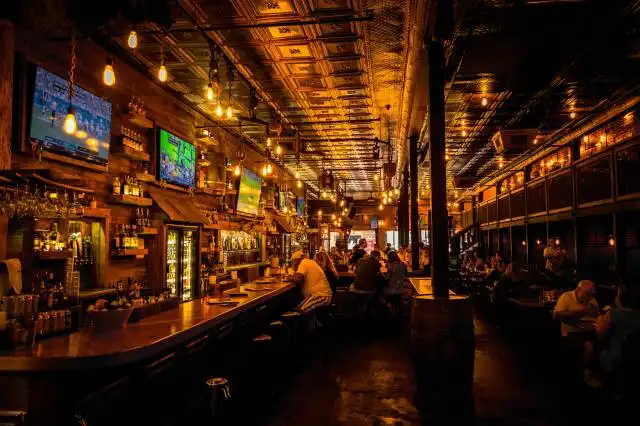Start a Bar
Creating Your Own Hub of Cheers and Beers: The Enthralling Journey of Bar Ownership
| Updated


BAR
Imagine presiding over the perfect nexus of relaxation and conviviality, that's exactly the charm of owning a bar. Bars, as a lively hotspot for socialising and unwinding, serve a variety of beverages from alcoholic to non-alcoholic fare. As a first-time bar owner, prepare to be the conductor of a symphony of toasts, tears, and laughter, all while serving up the best suds and spirits in town. Bottoms up to your new venture!
Jump to Business Plan
RELATED BUSINESS IDEAS
Browse ALL Food & Beverage Entrepreneurship Business Ideas
Discover Your Perfect Domain
Unlock the door to your online success with our hand-picked selection of premium domain names. Whether you're starting a new venture or rebranding an existing one, the right domain can set the tone for your digital presence. Browse through our curated list, each with its unique potential to enhance your brand's visibility and credibility.
BAR MINI BUSINESS PLAN
This a quick reality check to help you identify the strengths and weaknesses of your business concept before you dive in.
Expected Percent Margin:
- Gross Margin: Typically, bars have a gross margin of around 70-80%.
- Net Profit Margin: For most bars, this will sit closer to 10-15%.
Earnings Expectations:
- Daily Earnings: Depending on location and patronage, this could be from $500 to $2000.
- Weekly Earnings: Larger bars and pubs might see earnings from $3,500 to $14,000.
- Monthly Earnings: This puts us at a range of $14,000 to $60,000.
- Annual Earnings: On the higher end, your pub could bring in approximately $168,000 to $720,000 per year.
Actions to Hit Those Numbers:
Staff & Beverage Management:
- Initial Investment: An estimated $110,000 to $550,000 depending on the size and location of the bar.
- Supplier Network: Develop relationships with several beer, wine, and spirit distributors to ensure a variety of offerings.
Marketing and Customer Acquisition:
- Social Media: Utilize platforms to keep patrons informed about events or special promotions.
- Local Advertising: Consider utilizing local resources, such as newspapers or radio stations, to reach potential customers.
Sales and Customer Experience:
- Staffing: Employ experienced staff who can provide excellent customer service.
- Special Events: Host weekly events such as trivia or happy hour specials to attract repeat business.
Cost Control:
- Rent: Depending on the location, expect to set aside a large portion of overhead costs to cover rent. Look for a site that matches your expected foot traffic.
- Utilities and Maintenance: Many bars budget around $20,000 to $50,000 annually for these expenses, depending on size and location.
Business Operations:
- Open Hours: Hours differ, though most bars operate into the late-night hours, especially on weekends.
- Transaction Volume: Depending on the size of your bar, this could range widely. Aiming for 100-200 transactions per day would be a good start.
Each of these numbers can fluctuate based on your specific situation. Consult with a business advisor or fellow entrepreneur to ensure you're launching with the best plan possible!
NOT WHAT YOU HAD IN MIND? Here are more ideas



Browse ALL Food & Beverage Entrepreneurship Business Ideas
Grab Your Business Website Name
Before you get caught up in the whirlwind of setting up your business, invest in a domain name. It's a small but significant step that lays the foundation for your brand and makes it easier for customers to find and trust you. Just like you wouldn't build a house without securing the land first, don't build a business without securing your domain name.
"Why? Can't that wait?" Here's why it shouldn't
Step 1: Determine if Starting a Bar is the Right Endeavor
Breakdown of Startup Expenses
Before starting a bar, it is important to understand the startup costs associated with the business. This includes expenses such as the cost of the building, liquor license, equipment, furniture, and supplies. It is also important to factor in the cost of hiring staff, such as bartenders, servers, and cooks. Additionally, the cost of marketing and advertising should be considered. Lastly, it is important to factor in the cost of insurance, which can help protect the business in the event of an accident or lawsuit.
Breakdown of Ongoing Expenses
Once the bar is up and running, there are ongoing expenses that must be taken into account. These include rent or mortgage payments, utilities, payroll, and supplies. Additionally, the cost of marketing and advertising should be factored in, as well as the cost of insurance. It is also important to factor in the cost of maintenance and repairs, as well as the cost of taxes and fees.
Examples of Ways to Make Money
There are a variety of ways to make money in a bar. The most common way is to sell alcoholic beverages, such as beer, wine, and spirits. Additionally, food and non-alcoholic beverages can be sold. Additionally, hosting events such as trivia nights, karaoke nights, or live music can help to bring in more customers. Lastly, offering discounts or promotions can help to attract more customers and increase sales.
Step 2: Name the Business
Brainstorm ideas When brainstorming ideas for the name of your business, it is important to consider the type of bar you are opening and the atmosphere you are trying to create. Think about what words and phrases best describe the bar and the experience you want to provide to your customers. Additionally, consider the geographic area where the bar is located and the type of people you are trying to attract.
Use a thesaurus Using a thesaurus can be a great way to come up with creative and unique names for your business. Look up words that are related to the type of bar you are opening and the atmosphere you are trying to create. Additionally, look up words that are related to the geographic area where the bar is located.
Check for availability Once you have a few potential names for your bar, it is important to check for availability. Make sure that the name you choose is not already taken by another business. Additionally, check to see if the domain name is available for the website you plan to create for your bar.
Consider trademarking If you have a name that you really like, you should consider trademarking it. This will help protect your business from competitors who may try to use the same name. Additionally, it will help protect your business from any legal issues that may arise from using a name that is already taken.
Get feedback Before you make a final decision on the name of your business, it is important to get feedback from family, friends, and potential customers. Ask them what they think of the name and if they think it accurately reflects the type of bar you are opening. Additionally, ask them if they think the name is catchy and memorable.
Step 3: Obtain Licenses and Permits
Before opening a bar, it is important to understand the licenses and permits required to operate a business. Depending on the state, the type of business, and the services offered, the licenses and permits required may vary. For example, a bar may need a liquor license, a food service license, and a business license. It is important to research the specific licenses and permits required in the state and locality where the business will be located.
Obtaining Licenses and Permits
Once the licenses and permits required are identified, the next step is to obtain them. Depending on the state and locality, this process can take anywhere from a few days to a few months. In some cases, the process may require a public hearing or a review by a local board. Additionally, the process may require the payment of fees, the completion of forms, and the submission of documents. It is important to understand the process and timeline for obtaining the required licenses and permits.
Tips for Obtaining Licenses and Permits
When applying for licenses and permits, it is important to be prepared. This includes having all the necessary documents and forms ready, understanding the fees and payment process, and being aware of any deadlines. Additionally, it is important to be aware of any local zoning laws or regulations that may apply to the business. Finally, it is important to contact the local licensing office to ensure that all the necessary steps are taken to obtain the required licenses and permits.
Step 4: Secure a Location
Consider the local market When choosing a location for your bar, it is important to consider the local market. Think about the types of people who live in the area, what type of bar they would be interested in, and what type of competition you may have. You should also consider the cost of rent and the size of the space you need.
Analyze the local competition It is also important to analyze the local competition. Look at the other bars in the area and consider what makes them successful. This will help you determine what type of bar you should open and how you can differentiate yourself from the competition.
Consider the zoning regulations Before you choose a location for your bar, you should make sure that the zoning regulations in the area allow for a bar. You should also make sure that the building is up to code and that you have the necessary permits and licenses to operate a bar.
Look for a space that fits your vision When choosing a location for your bar, you should look for a space that fits your vision. Think about the type of atmosphere you want to create and look for a space that can accommodate that. Make sure that the space has the necessary amenities, such as a kitchen, bathrooms, and seating.
Consider the accessibility of the location Finally, you should consider the accessibility of the location. Make sure that the location is easy to find and that there is plenty of parking available. You should also consider the public transportation options in the area and make sure that your customers will be able to get to your bar easily.
Step 5: Design the Bar
Consider the theme of the bar When designing the bar, it is important to consider the theme of the bar. This will help to create a unique atmosphere for customers to enjoy. Think about the type of customers you want to attract and the type of atmosphere you want to create. Consider the colors, furniture, and decorations that will best fit the theme.
Utilize the space When designing the bar, it is important to make the most of the space. Think about the layout of the bar and how to best utilize the space. Consider the placement of the bar, tables, chairs, and other furniture. Also, think about the placement of the bathrooms, kitchen, and other areas.
Incorporate technology When designing the bar, it is important to consider incorporating technology. This can include televisions, music systems, and other electronic devices. This can help to create a more enjoyable atmosphere for customers.
Choose the right lighting When designing the bar, it is important to choose the right lighting. This can help to create the right atmosphere and can help to make the bar more inviting. Consider the type of lighting that will best fit the theme of the bar and the type of atmosphere you want to create.
Consider safety When designing the bar, it is important to consider safety. Think about the placement of the furniture and the placement of the bar. Also, consider the placement of the bathrooms and other areas. This can help to ensure the safety of customers and staff.
Step 6: Hire Employees
When hiring employees for your bar, it is important to find the right people who will be a good fit for your business. You should look for people who have experience in the hospitality industry and who have a good attitude and work ethic. You should also make sure that your employees are familiar with the laws and regulations related to alcohol service. Additionally, you should conduct background checks and drug tests on potential employees to ensure that they are qualified and trustworthy. Finally, you should provide training to your employees so that they are knowledgeable about the products and services you offer.
Benefits of Hiring Employees
Hiring employees can be beneficial to your business in many ways. Having employees can help you to manage the workload and ensure that your bar is running smoothly. Additionally, having employees can help you to provide better customer service and create a better overall experience for your customers. Furthermore, having employees can help to reduce the amount of stress on you as the business owner, as you will not have to do all of the work yourself. Finally, having employees can help to increase the profits of your business, as they can help to increase the efficiency of your operations.
Step 7: Stock the Bar
- Consider the type of bar you are opening. Depending on the type of bar, you may want to stock different types of alcohol. For example, if you are opening a sports bar, you may want to stock a variety of beers and liquors, while if you are opening a wine bar, you may want to focus on stocking a variety of wines.
- Consider the location of your bar. If you are opening a bar in a tourist area, you may want to stock a variety of international drinks. If you are opening a bar in a college town, you may want to stock a variety of craft beers.
- Consider the budget for stocking the bar. You may want to start with a limited selection of drinks and expand as your business grows. You may also want to consider offering discounts on certain drinks to attract customers.
- Consider the size of your bar. If you have a small bar, you may want to focus on stocking a limited selection of drinks. If you have a larger bar, you may want to stock a wider selection of drinks.
- Consider the type of customers you are targeting. If you are targeting a younger crowd, you may want to stock a variety of flavored drinks and mixers. If you are targeting an older crowd, you may want to stock a variety of classic cocktails.
Step 8: Market the Bar
Introduction: Marketing a bar is an important part of the business plan. It is essential to get the word out about the bar and to attract customers. This step will outline some tips for marketing the bar.
Social Media: Social media is a great way to get the word out about the bar. It is free and can reach a large audience quickly. Create a Facebook page, Twitter account, and Instagram account for the bar and post regularly. Make sure to use relevant hashtags and post engaging content.
Events: Hosting events is a great way to get people in the door. Consider hosting a grand opening event, live music nights, trivia nights, and other special events. Make sure to promote these events on social media and through other marketing channels.
Promotions: Offering promotions is a great way to attract customers. Consider offering discounts for happy hour, discounts for large groups, and discounts for special occasions. Make sure to promote these promotions on social media and through other marketing channels.
Advertising: Advertising can be a great way to reach a large audience. Consider placing ads in local newspapers, radio stations, and websites. Make sure to track the effectiveness of these ads and adjust as needed.
Word of Mouth: Word of mouth is one of the most powerful forms of marketing. Encourage customers to spread the word about the bar and offer incentives for doing so. Consider offering discounts or free drinks for customers who refer their friends.
Conclusion: Marketing the bar is an important part of the business plan. Utilizing social media, hosting events, offering promotions, advertising, and word of mouth are all great ways to get the word out about the bar and attract customers. With the right marketing plan, the bar can be successful.
Step 9: Open the Bar
Have a Grand Opening When it comes to opening the bar, it's important to make a grand entrance. This can be done by hosting a grand opening event with a special menu, live music, and other entertainment. Invite friends, family, and local media to the event to help spread the word about the bar.
Hire a Professional Hiring a professional to help with the opening of the bar can be a great way to ensure that everything runs smoothly. A professional can help with the setup of the bar, the ordering of supplies, and the hiring of staff.
Market the Bar Marketing the bar is essential for success. This can be done through social media, local advertising, and word-of-mouth. Create a website and social media accounts to promote the bar and its offerings.
Train Staff Training staff is an important part of opening the bar. Make sure that all staff members are properly trained in customer service, safety, and bar operations. This will ensure that the bar runs smoothly and efficiently.
Set Up a Point of Sale System Setting up a point of sale system is essential for tracking sales and managing inventory. Make sure to choose a system that is easy to use and secure. This will help to ensure that the bar runs smoothly and efficiently.
EXPLORE MORE CATEGORIES
Browse ALL Business Idea Categories
TAKE THE NEXT STEPS










